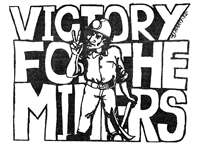
 |
Online
Archive
|
| Issue 3 - March 1972 |
| The Black Facts |
 15
years ago there were 700,000 miners in this country producing 212,000,000
tons of coal a year. Before the strike this year, there were 280,000 miners
producing 140,000,000 tons of coal a year. That means the coal miner has
pushed his productivity up by about 70% in that time - a figure surpassed
by no other industry. At the same time, miners' real wages have slipped
25%. 15
years ago there were 700,000 miners in this country producing 212,000,000
tons of coal a year. Before the strike this year, there were 280,000 miners
producing 140,000,000 tons of coal a year. That means the coal miner has
pushed his productivity up by about 70% in that time - a figure surpassed
by no other industry. At the same time, miners' real wages have slipped
25%.
Of the 280,000 miners employed by the NCB today, 86,000 earned less than £20 a week basic before the strike. Many had to work several double shifts a week (i.e. 15 hours) in order to bring home a relatively decent wage packet. Working conditions in the mines would be unacceptable in any other industry - with no toilets, rest rooms or facilities for hot meals and drinks, and horribly cramped working spaces (in Bearpark in County Durham miners chip coal with picks from thirteen inch high shafts. Imagine lying on your belly for hour after hour, day after day, with the roof an inch above your head and the walls only a few inches wider than your body!) Face work is probably the most unpleasant and dangerous of jobs. In 1971 - an ordinary year for the industry, with no major disasters - provisional figures state that 69 men were killed and 639 seriously injured in the mines. Officially 673 miners died of pneumoconiosis last year. In fact it
is estimated that over 4,000 miners and ex-miners die from this disease
each year. The official figures are so low because doctors dislike diagnosing
this disease as the cause of death. With the introduction of new high-speed
cutting machinery more dust is raised, making the problem even worse,
and the death rates higher. When a miner 'officially' dies of pneumoconiosis,
his widow gets £150 plus £2.67½p a week plus free
coal for life. The miners' union has never seriously campaigned for
higher pensions for its members, as not many live past retirement age. |